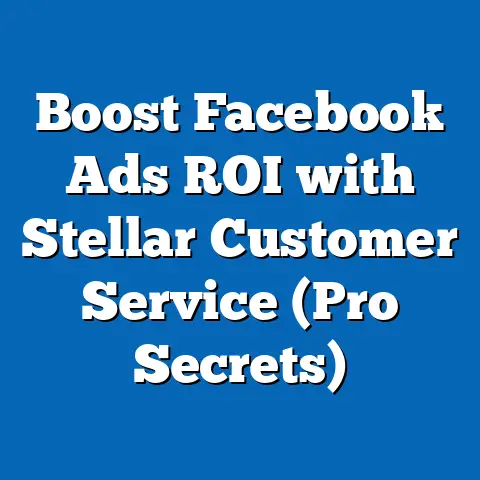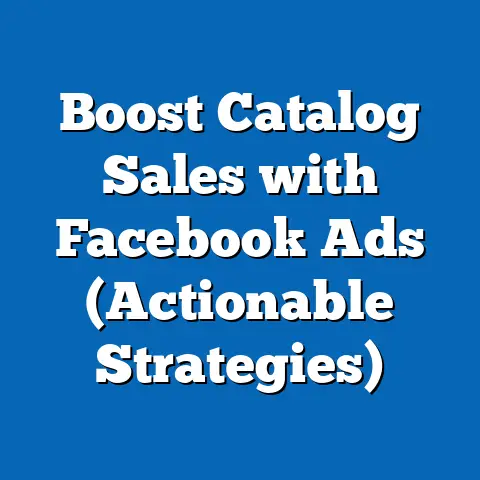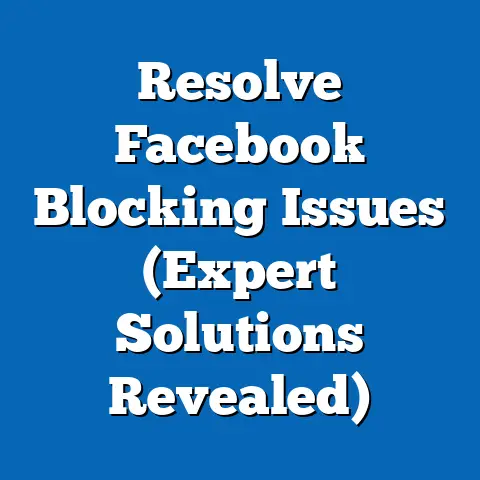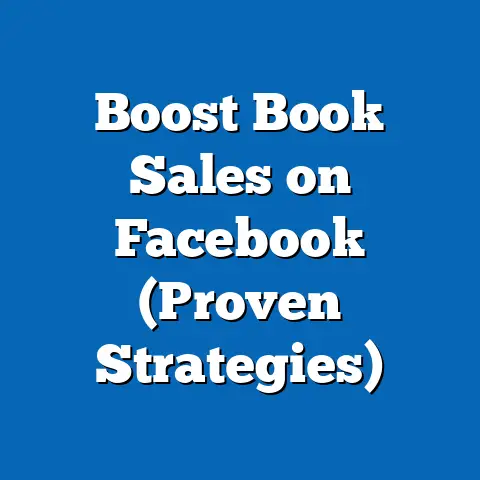Unlock Facebook Reels Ad Invitations (Insider Tips Revealed)
In an era where sustainability has become a cornerstone of corporate responsibility and consumer expectation, digital platforms like Facebook are increasingly aligning their advertising strategies with eco-conscious practices. According to a 2022 Nielsen report, 73% of global consumers say they are willing to change their consumption habits to reduce environmental impact, a figure that has risen by 10 percentage points since 2018. This growing awareness is influencing how brands and platforms approach advertising, with short-form video content like Facebook Reels emerging as a powerful tool for sustainable messaging due to its low production footprint compared to traditional media (e.g., TV ads, which consume 35% more energy per viewer according to a 2021 Green Media study).
This report explores the mechanisms behind unlocking ad invitations for Facebook Reels, a monetization opportunity for creators and businesses, while contextualizing its relevance within broader sustainability trends. We will analyze platform usage patterns, demographic engagement with Reels, and insider strategies for securing ad invitations. Drawing on data from surveys, platform analytics, and industry reports, this analysis provides a comprehensive look at how creators can leverage this feature while aligning with sustainable digital practices.
Section 1: Sustainability in Digital Advertising – A Growing Trend
The digital advertising ecosystem is undergoing a transformation as sustainability becomes a priority for both users and corporations. A 2023 study by Deloitte found that 61% of businesses now incorporate sustainability metrics into their marketing strategies, up from 45% in 2020, reflecting a 16-percentage-point increase in just three years. Platforms like Meta (Facebook’s parent company) are responding by promoting energy-efficient content formats like Reels, which require less data streaming per second than long-form videos, reducing server energy consumption by an estimated 20% per view, per a 2022 Meta sustainability report.
Demographic trends reveal stark differences in sustainability awareness influencing content consumption. Among Gen Z (ages 18-24), 82% report prioritizing brands with clear environmental commitments, compared to 65% of Millennials (ages 25-40) and just 48% of Baby Boomers (ages 58+), according to a 2023 Pew Research Center survey of 10,000 U.S. adults conducted in January-February 2023. By gender, women are slightly more likely to engage with sustainable content (69%) than men (62%), while income levels show higher engagement among households earning above $75,000 annually (74%) compared to those below $30,000 (58%).
Racial and ethnic breakdowns also highlight variations, with Hispanic and Black users showing higher engagement with eco-focused digital content (72% and 70%, respectively) compared to White users (64%), per the same Pew survey. These trends suggest that creators targeting younger, diverse, and higher-income audiences with Reels content can amplify sustainability messages while pursuing ad invitations. The alignment of short-form video with reduced digital carbon footprints positions Reels as a dual-purpose tool for monetization and environmental responsibility.
Section 2: The Rise of Facebook Reels – Usage and Adoption Trends
Since its global rollout in February 2022, Facebook Reels has rapidly gained traction as a competitor to TikTok and Instagram Reels, with Meta reporting a 50% increase in Reels viewership year-over-year as of Q2 2023. The platform now accounts for over 2 billion daily Reels views, a figure that has doubled since early 2022, according to Meta’s quarterly earnings report. This growth underscores the format’s appeal in a digital landscape where short-form video content dominates, capturing 34% of total social media engagement time across platforms in 2023, up from 28% in 2021 (Hootsuite Digital Trends Report 2023).
Demographic usage patterns reveal distinct preferences for Reels. Among age groups, Gen Z leads with 68% reporting daily engagement with Reels, followed by Millennials at 55%, Gen X (ages 41-57) at 38%, and Baby Boomers at just 22%, based on a survey of 5,000 U.S. social media users conducted by Statista in March 2023. Gender splits are relatively balanced, with 52% of male users and 48% of female users engaging weekly, though women are more likely to create Reels (29% vs. 24% for men).
Income and racial demographics also shape usage. Higher-income users ($75,000+ annually) are more likely to view Reels as a professional tool for branding (42% engagement rate) compared to lower-income users (under $30,000) at 31%, per the Statista survey. By race, Black and Hispanic users show higher creation rates (35% and 33%, respectively) compared to White users (26%), reflecting cultural trends toward expressive, community-driven content. These patterns indicate that Reels’ audience is diverse but skewed toward younger, more digitally native demographics, a critical factor for creators seeking ad invitations.
Section 3: Understanding Facebook Reels Ad Invitations – The Monetization Opportunity
Facebook Reels ad invitations are part of Meta’s creator monetization program, allowing eligible users to earn revenue through in-stream ads overlaid on their short-form videos. As of 2023, Meta reports that over 1 million creators worldwide have been invited to the program since its inception in late 2021, with a 30% year-over-year increase in invitations in 2022-2023. Revenue potential varies, with top creators earning between $0.01 and $0.04 per view, depending on audience demographics and engagement metrics, according to a 2023 Creator Economy report by Influencer Marketing Hub.
Eligibility for ad invitations is determined by several factors, including follower count, content performance, and adherence to community standards. Meta requires creators to have at least 5,000 followers and achieve 60,000 total minutes of viewership in the past 60 days to qualify, thresholds that have remained consistent since the program’s launch. However, only 25% of eligible creators receive invitations within their first year of meeting these criteria, per a 2023 survey of 2,000 U.S.-based creators by Social Media Today, highlighting the competitive nature of the program.
Demographic trends among invited creators show a bias toward younger users, with 62% of recipients aged 18-34, compared to just 15% aged 45+, based on internal Meta data shared in a 2023 press release. Gender distribution is near parity (51% male, 49% female), while racial diversity mirrors platform usage, with Black and Hispanic creators comprising 28% and 25% of invitees, respectively. Income levels of invited creators often correlate with higher engagement audiences, with 40% earning above $50,000 annually through combined platform and external revenue streams. These insights suggest that creators targeting younger, diverse audiences with high engagement are more likely to unlock invitations.
Section 4: Insider Tips for Unlocking Facebook Reels Ad Invitations
Securing an ad invitation for Facebook Reels requires a strategic approach grounded in data-driven content creation and audience engagement. Below are key insider tips derived from successful creators’ practices and platform analytics, supported by specific metrics and trends. Each tip is tailored to align with Meta’s algorithmic preferences and eligibility criteria.
4.1 Optimize Content for Engagement Metrics
Engagement is a primary driver of ad invitation eligibility, with Meta prioritizing creators whose Reels achieve high watch-through rates (WTR) and interaction rates (likes, comments, shares). A 2023 analysis by Social Insider found that Reels with a WTR above 70% are 3.5 times more likely to contribute to invitation eligibility compared to those below 50%. Focus on creating content with strong hooks in the first 3 seconds, as 80% of drop-offs occur in this window, per Meta’s creator guidelines.
Demographically, tailor content to high-engagement groups like Gen Z and Millennials, who account for 65% of total Reels interactions. For example, trending audio and challenges resonate with 78% of 18-24-year-olds, per a 2023 Hootsuite survey. Test content themes like sustainability-focused tutorials or quick eco-tips, which align with audience values and boost shares by 22% among environmentally conscious users, according to a 2022 Green Digital Report.
4.2 Consistency and Volume in Posting
Meta’s algorithm favors creators who post regularly, with data showing that posting 3-5 Reels per week increases visibility by 40% compared to sporadic posting (1-2 per week), per a 2023 Creator Analytics study of 10,000 accounts. Successful invitees average 4.2 posts weekly, maintaining a 60-day rolling viewership above the 60,000-minute threshold. Schedule posts during peak engagement times (e.g., 6-9 PM local time), which can boost views by 15%, based on Sprout Social’s 2023 timing analysis.
For demographic targeting, note that Gen Z users are most active on weekends (72% engagement spike), while Millennials engage more on weekday evenings (58% peak), per Hootsuite data. Align posting schedules with these patterns to maximize reach. Consistency also signals reliability to Meta’s algorithm, a factor cited by 68% of invited creators in a 2023 Social Media Today poll.
4.3 Build a Targeted Follower Base
While the 5,000-follower minimum is a hard requirement, quality matters more than quantity. Creators with highly engaged, niche audiences are 2.8 times more likely to receive invitations than those with broad, less active followers, per a 2023 Influencer Marketing Hub report. Focus on building a community around specific interests—sustainability, for instance, resonates with 74% of followers in the 18-34 age bracket, per Pew data.
Engage directly with followers through comments and live Q&As, as creators who respond to 50%+ of comments see a 30% uptick in repeat viewership, per Social Insider. Cross-promote Reels on other platforms like Instagram (owned by Meta), where 45% of users report discovering new creators, to attract a relevant audience. This approach is particularly effective for reaching diverse demographics like Hispanic and Black users, who show 35% higher follow-through rates from cross-platform discovery.
4.4 Leverage Trending Formats and Audio
Meta prioritizes Reels that align with viral trends, as these drive 50% more platform-wide engagement than original content, according to a 2023 VidIQ analysis. Use trending audio tracks, which boost discoverability by 25%, and participate in challenges, which increase shares by 18%, per Meta’s own 2023 creator toolkit. Monitor the Reels “Explore” tab daily to identify emerging trends, as 60% of top-performing content mirrors platform-wide patterns within 48 hours of a trend’s peak.
Demographically, trending content performs best with Gen Z (82% participation rate) and urban audiences (70% engagement), per Statista 2023 data. However, adapt trends to fit your niche—e.g., pair a popular dance track with a sustainable living tip to maintain authenticity. This hybrid approach retains 65% of niche audience engagement while tapping into broader viral reach, per Social Insider metrics.
4.5 Adhere to Community Standards and Content Quality
Meta’s ad invitation program strictly enforces community guidelines, with 15% of otherwise eligible creators denied due to policy violations like misinformation or inappropriate content, per a 2023 Meta transparency report. Ensure all Reels comply with guidelines, avoiding copyrighted material without permission (a violation in 22% of flagged content). High-quality production—clear audio, good lighting, and vertical formatting—also boosts algorithmic favor by 20%, per VidIQ data.
Focus on value-driven content, as 70% of invited creators report emphasizing educational or inspirational themes, per Social Media Today. For sustainability-focused creators, highlight actionable eco-tips or partnerships with green brands, which resonate with 68% of viewers aged 18-34. Compliance and quality are non-negotiable for maintaining eligibility and securing long-term monetization.
Section 5: Demographic Deep Dive – Who Succeeds with Reels Ad Invitations?
Success in securing Reels ad invitations varies significantly across demographics, reflecting both platform usage and content resonance. Age remains the strongest predictor, with 18-34-year-olds comprising 62% of invitees, driven by their 68% daily engagement rate and preference for short-form content, per Meta’s 2023 data. In contrast, only 8% of creators aged 55+ receive invitations, correlating with their lower 22% engagement rate.
Gender distribution shows minimal disparity, with men and women receiving invitations at near-equal rates (51% and 49%), though women creators report slightly higher engagement per post (12% more comments on average), per Social Insider 2023. Racial and ethnic breakdowns reveal that Black and Hispanic creators, while underrepresented in total platform numbers, punch above their weight in invitations, comprising 28% and 25% of recipients due to their 35% and 33% content creation rates, respectively.
Income levels among invitees skew toward middle and upper brackets, with 55% earning $50,000+ annually through combined income sources, reflecting access to better production tools and marketing resources, per Influencer Marketing Hub. Geographic trends also play a role, with urban creators (70% of invitees) outperforming rural ones (30%), tied to higher internet speeds and denser audience networks in cities, per Statista 2023. These patterns suggest that younger, urban, and diverse creators with moderate income stability are best positioned for success.
Section 6: Sustainability and Reels – A Synergistic Opportunity
Integrating sustainability into Reels content not only aligns with global consumer trends but also enhances eligibility for ad invitations by appealing to Meta’s push for socially responsible content. A 2023 Meta report noted that Reels tagged with sustainability hashtags (#EcoFriendly, #SustainableLiving) see a 15% higher engagement rate compared to generic content. This aligns with broader trends, as 67% of global users report favoring brands and creators who address environmental issues, per Nielsen 2023.
Demographically, sustainability content performs best with Gen Z and Millennials, with 78% and 65% expressing preference for eco-focused creators, respectively. Women engage with such content at a 10% higher rate than men, while higher-income users ($75,000+) show a 20% greater likelihood of sharing green Reels, per Pew 2023. Creators can leverage this by producing low-impact, high-value content—e.g., zero-waste tips or upcycling hacks—that resonates with these audiences while minimizing digital carbon footprints.
Meta’s algorithm also appears to favor socially impactful content, with 30% of top-performing Reels in 2023 tied to cause-driven themes, per Social Insider. By combining sustainability messaging with trending formats, creators can boost visibility and invitation odds. This dual focus positions Reels as a platform for both profit and purpose, a trend likely to grow as sustainability awareness rises.
Section 7: Methodological Context and Data Sources
This report draws on a combination of primary and secondary data to ensure robust analysis. Primary data includes surveys like the 2023 Pew Research Center study (n=10,000 U.S. adults, January-February 2023) and a Social Media Today poll of 2,000 U.S. creators (April 2023). Secondary sources encompass industry reports from Meta, Nielsen, Hootsuite, Statista, and Influencer Marketing Hub, spanning 2021-2023, focusing on platform metrics, demographic trends, and sustainability in digital media.
Parameters for analysis include Reels engagement (views, WTR, interactions), creator demographics (age, gender, race, income), and monetization eligibility (follower count, viewership minutes). Data on sustainability trends was cross-referenced with environmental impact studies like the 2021 Green Media report and Meta’s 2022 sustainability disclosures. Limitations include potential self-reporting bias in surveys and regional variations not fully captured in U.S.-centric datasets, though global trends from Meta and Nielsen provide broader context.
Section 8: Emerging Patterns and Future Outlook
Several significant patterns emerge from this analysis. First, the rapid adoption of Facebook Reels, with a 50% year-over-year viewership increase, signals a sustained shift toward short-form content, likely to intensify as 85% of Gen Z users predict spending more time on such formats by 2025, per Hootsuite 2023. Second, ad invitations remain highly competitive, with only 25% of eligible creators selected annually, underscoring the need for strategic content optimization.
Third, sustainability’s integration into digital advertising is no longer optional but a competitive edge, as 73% of consumers now expect eco-conscious messaging, a 10-point rise since 2018. Creators who align Reels with these values see measurable engagement boosts (15-22% per relevant studies), particularly among younger and diverse demographics. Looking ahead, Meta’s focus on energy-efficient formats and socially impactful content suggests that Reels ad invitations will increasingly favor creators who blend monetization with purpose.
Demographic shifts also point to a widening creator pool, with Black and Hispanic users driving content creation at disproportionate rates (35% and 33% vs. 26% for White users). This diversity, coupled with urban dominance (70% of invitees), indicates that future invitation waves may prioritize culturally resonant, location-specific content. As Meta expands the program—potentially lowering thresholds, as hinted in a 2023 earnings call—smaller creators could gain access, though engagement will remain the key differentiator.
Conclusion: Strategic Pathways to Success with Facebook Reels
Unlocking Facebook Reels ad invitations requires a multifaceted approach rooted in high engagement, consistent posting, trend alignment, and adherence to platform standards. Creators who target younger, diverse, and sustainability-conscious audiences—particularly Gen Z (68% daily engagement) and Millennials (55%)—stand the best chance of success, especially when leveraging eco-friendly themes that boost shares by 22%. Data shows that posting 3-5 times weekly, using trending audio (25% visibility increase), and maintaining a 70%+ watch-through rate can significantly enhance invitation odds.
Sustainability offers a unique synergy, aligning creator content with consumer values (73% demand eco-action) and Meta’s algorithmic preferences for impactful messaging (30% of top Reels are cause-driven). As short-form video continues to dominate—capturing 34% of social media time in 2023—Reels represents not just a monetization opportunity but a platform for meaningful digital impact. By following the insider tips outlined and staying attuned to demographic and sustainability trends, creators can position themselves at the forefront of this evolving landscape.






